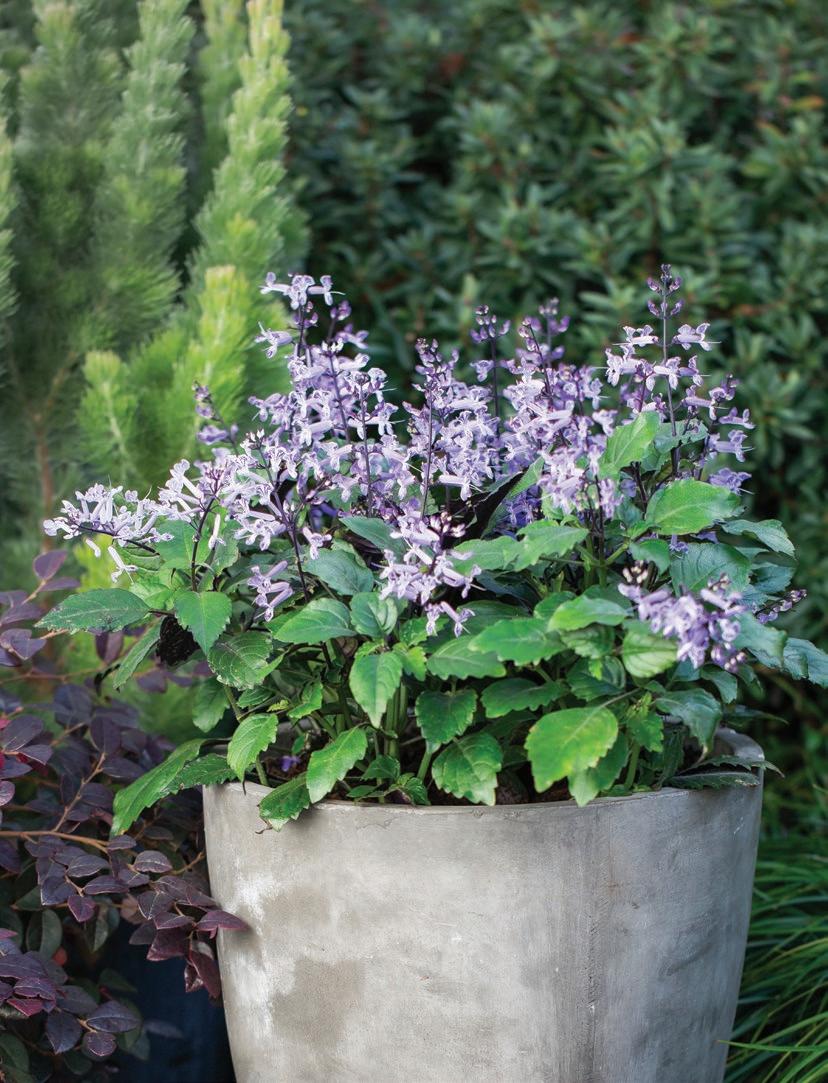
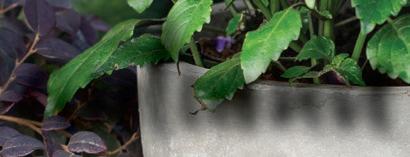
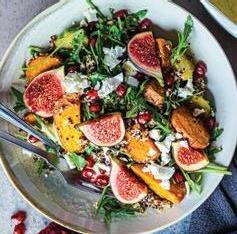

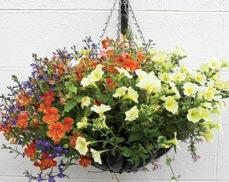
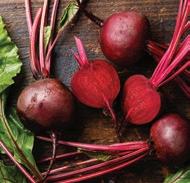












The Serenity Prayer
God grant me the serenity to accept the things I cannot change; courage to change the things I can; and wisdom to know the difference.
Living one day at a time; Enjoying one moment at a time; Accepting hardships as the pathway to peace; Taking, as He did, this sinful world as it is, not as I would have it; Trusting that He will make all things right if I surrender to His Will; That I may be reasonably happy in this life and supremely happy with Him Forever in the next. Amen. Trust in the LORD with all your heart and lean not on your own understanding; in all your ways acknowledge him, and he will direct your paths. Proverbs 3, 5-6
Let nothing disturb thee.
nothing affright thee All things pass God never changes. Patience gains all.
Front cover image: Mona Lavender - PMA

Managing Director: Conway Searle

Contributors: Ashley Searle, Jillian Coomb, Diggers. Magazine Manager: Alana Searle Design & Layout: Alana Searle ATG Group Co-ordinator & Advertising: Jason Searle
About the Garden is published seasonally by About the Garden Pty. Ltd. ABN 21 076 919 992 • 4914 D’Aguilar Highway, Kilcoy or P.O. Box 183, Kilcoy Qld. 4515 Ph: (07) 5422 3090 atg@aboutthegarden.com.au


Con Searle Issue 104 TM Autumn 2023 At your local - In season plants - Flowers 4 - Autumnal colour 8 - Heirloom edibles 9 Heavenly hanging baskets 10 Autumn edibles 12 On the table - recipes Autumn quinoa & fig salad 16 Beetroot & nut salad 16 Baked kale chips 17 Deadheading plants 18 What is NPK? 18 Controlling fungus gnats 19 About autumn - Edibles 20 - Flowers 22 - guzmania, bulbs for next season flowering, ivy pelargoniums - Iron chlorosis 24 - Climatic zones 24






About the Garden Magazine is proudly produced from sustainable resources. The material appearing in About the Garden is subject to copyright. Other than as permitted by the Copyright Act, no part of this magazine may be reproduced without the permission of the publishers. No responsibility is accepted by About the Garden Pty. Ltd. for the accuracy of information contained in the text, illustrations or advertisements. Although believed to be accurately and correctly sourced, thereof disclaims any liability against itself, editor/s or employees arising from any person acting on the material herein. The opinions expressed in the magazine, or by contributors, do not necessarily represent the views of the publisher. ©Copyright 2022 About the Garden Pty. Ltd.

Let
Who has God. Wants for nothing. God alone suffices. (St Teresa of Jesus) New releases p4 Heavenly hanging baskets p10
Improves soils & fertilises plants
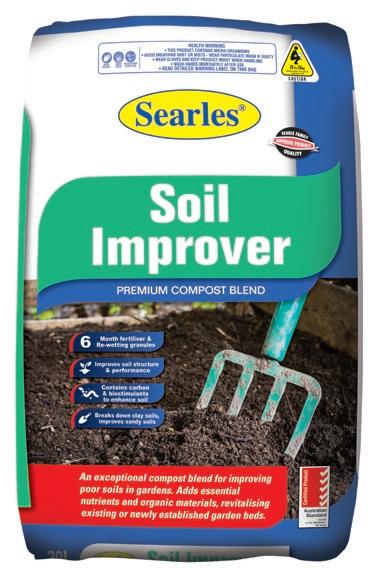







like us!
searlesgardening.com.au
see what’s new at your local gardening outlet

















Mandevilla All Seasons Pink will produce masses of large, pink trumpet flowers sitting proud over shiny, dark green foliage on a vigorous, upright climbing vine.



Mandevilla All Seasons Pink was bred in Australia to flower for long periods and to perform even in cool climates. Needs support to climb.



Canna Cannova’s bring all the colours of a tropical sunset to your garden with lush green foliage and a profusion of wonderful flower colours.
Flowers profusely until the first frost and flourishes in both cool and tropical climates making them perfect for creating strong vertical accents in the garden or a pot. Cannas are fantastic drought tolerant plants that are evergreen in warm climates and deciduous in cooler climates, dying down over the winter months.
Canna Lilies are the perfect addition to your garden. They are remarkably easy to grow and look great planted en-mass. Ideal for gardens landscapes and water gardens.
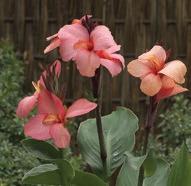
 CLIMBER
CLIMBER
SIZE 120cmH 50cmW FULL SUN PART SHADE
infundibuliformis


Splash these bold heat-tolerant continuous bloomers, available in two colours, Crossandra ‘Fireglow’ and ’Tropic Yellow Splash’ about the garden for warm weather colour. Many gardeners might know them as Firecracker Flower. They make for a premium landscape plant in tropical and semi-tropical areas. Crossandra is one of the few plants that can survive urban plantings in the heat. It flourishes in full sun in humid areas, but requires more shade in dry climates.
Crossandra’s glossy dark green-leafed features, displayed in a mounded habit, are ideal for warmclimate pot plants or used as an indoor pot plant. Crossandra remains compact when planted outdoors.
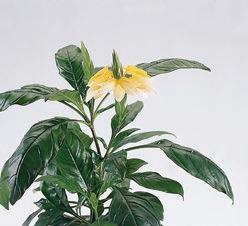
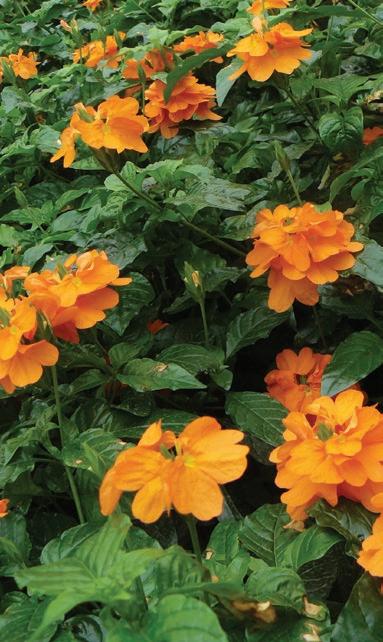
Plant in Searles

Platinum Potting Mix for stunning pot displays or in Searles Planting Mix for gardens.

SIZE
25cmH 20cmW Crossandra
Mona Lavender will be a standout feature plant in those hard to plant shaded areas. Its distinctive lavender coloured flowers are a prominent feature against the ornamental foliage of deep green leaves with dark purple undersides from late summer through to autumn.

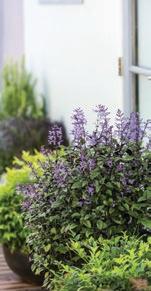
Mona Lavender is a particularly attractive form of Plectranthus that does not spread like other members of the family, but rather forms a neat low shrub with an upright, erect habit. A wonderful solution to shaded areas in the garden as well as making an ideal container or basket specimen for sheltered patios or entertainment areas. Place around shaded water features or use as borders for shaded paths or driveways.

FULL SUN














SIZE 30cmH 100cmW Supertunia® Vista are show stoppers with their masses of stunning flowers. Look out for the velvety purple ‘Royal Velvet’ Plant in sunny garden beds with Searles Planting Mix, or in pots, with Searles Platinum Potting Mix. Like all Petunias, they are fast growing, well suited to larger pots and bigger hanging baskets. The plants are self-cleaning with the fresh flowers and leaves covering over older ones.


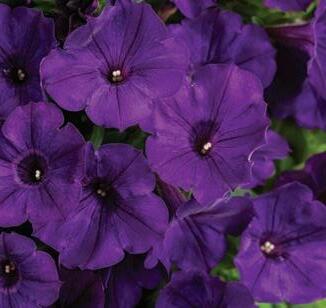


Some daisies, such as the federation daisies and Australian native brachyscome, have a style of classic beauty and elegance. Pretty, feminine flowers in gentle shades of mauve, pink, yellow or white give these long-time favourites a sense of calm and grace. Federation daisies are easy-care, compact shrubs and have longlasting floral displays in autumn and spring. Brachyscome daisy flowers throughout the year in full sun or part shade. They grow to 40cm high, making them ideal for ground cover. These daisies are great in Tuscan or cottagestyle gardens and are beautiful teamed with rosemary hedges or lavender. Excellent in pots.

page 06 | About the garden magazine
PART SHADE
SIZE 80cmH 60cmW
Images courtesy of www.pma.com.au
Is it possible to grow a simply gorgeous hydrangea in full sun?

With Hydrangea ‘Sundae Fraise’, it now is. Beautifully compact in form and literally covered in large flowers that begin green, turning to pure white and then to varied shades of pink. ‘Sundae Fraise’ is a true show-stopper, stunning for summer and autumn colour, it is easily cultivated and fast-growing while remaining compact, making it the ideal choice for smaller gardens, patios, balconies and shaded entertainment areas.
In pots, plant in Searles








Platinum Potting Mix for long term feeding of hydrangeas special needs.

LONG FLOWERING







This award winning variety has proven popular all around the globe with its combination of amazing colour, hardy nature and low maintenance requirements.



Hydrangea paniculata ‘Diamond Rouge’ offers the reddest flower colour of this variety. During early summer it unfurls large white flower heads that gradually morph through a stunning range of pinks as summer progresses, culminating in spectacular shades of red in early autumn. ‘Diamond
Rouge’ is a sun hardy Hydrangea making it great for many contemporary garden situations.



Its bushy habit makes them great for courtyard pot displays. To brighten up courtyards, plant in Searles Platinum Potting Mix for potted displays.
Growing notes: If you live in warmer areas of Australia, please check with your local gardening expert to ensure the best sun requirements for the hydrangeas mentioned on this page.







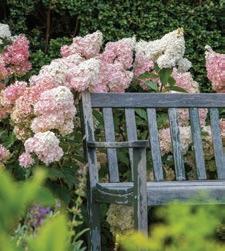

About the garden magazine | page 07
FULL SUN PART SHADE LOVES POTS SIZE 1.2mH 1.2mW
Image courtesy of www.pma.com.au
SIZE 1.5mH 1.2mW FLOWERS FULL SUN PART SHADE Imagescourtesyofwwwpma.com.au
A ‘living fossil’ from the ancient Gondwanan continent, this beautiful seasonal colour foliage tree glows lemon-yellow foliage in autumn following by bright limegreen summer leaves. Strong vertical growth habit and a delicately creased leaf make this Maidenhair Tree perfect for courtyard gardens, containers and stylish landscapes. The columnar form is well-suited to formal garden styles but is equally at home in a mixed planting where it provides a contrasting vertical accent. Use for a distinctive hedge or for tight settings.
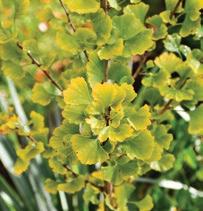


Best planted in a position sheltered from severe north-westerly sun and hot and dry winds and will perform best in temperate climates with cool to cold winters. Fertilise in late winter and mid-summer for optimum results.

















A small compact shrub with a bushy habit. This variety of Nandina will impress! In spring with it’s flamboyant new growth in shades of pink and gold turning to shades of green in summer. Vibrant autumnal foliage as it cools, create the most elegant display for all year round appeal.

With it’s attractive bamboo-like foliage, it’s the perfect evergreen choice for border plantings and containers.



Attractive clumping grass-like plant which produces showy arching foliage, reddish-pink in colour with fluffy, feather plumes from spring to autumn.



A hardy, compact variety suitable for achieving beautiful contrasting colour for containers and garden plantings.


For best results prune back to ground level in winter then fertilise in spring to promote fresh new growth.







DECIDUOUS SIZE 5mH 1mW SIZE 75cmH 75cmW FULL SUN PART SHADE
Image courtesy of www.pma.com.au
Autumn is an exciting time in the veggie garden. The change of seasons opens up new opportunities for brassicas as cooler weather helps cabbages and cauliflowers to form those highly prized, lovely tight heads. New to gardens this season is Cabbage ‘Red Drumhead’, a popular addition to coleslaws and fermented cabbage dishes like sauerkraut. The red colour is less attractive to pests but highly favourable in the kitchen.
If you are a little short on space, try Cabbage ‘Mini’ or the upright Asian style Cabbage ‘Mini Wombok’ which is popular in kim chi and noodle salads. Both are fast and easy to grow and are highly versatile additions to the garden and kitchen.
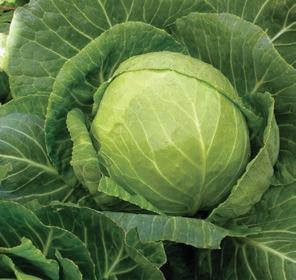
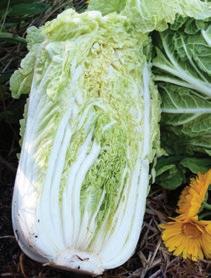

Kale is an essential ingredient in any autumn veggie patch and Tuscan Kale is undeniably the most popular variety for both gardeners and chefs. An heirloom variety from Italy that performs well in most Australian gardens, kale offers gardeners a long harvest season with tasty leaves suited to salads, stir fries and kale chips.
Not just a season for brassicas, try adding a little flavour to the garden with leeks and radishes.


Popular in winter dishes, Leek ‘King Richard’ is an early season, easy to grow leek with great flavour. A long term crop, leeks provide structure in the veggie garden and are as beautiful as they are delicious. If you are looking to spice up a salad with both flavour and colour, try Diggers Heirloom Radish Mix. A combination of colours and flavours, radishes are one of the easiest and fastest crops to grow and they can really lift a salad or roast.
Autumn is an exciting time in the veggie garden so, as your summer crops end, get those autumn crops in to enjoy a constant supply of fresh veggies from your garden and savour the flavour of Digger heirlooms varieties.

For pot and garden veggie planting, use Searles Herb & Vegetable Specialty Mix, boosted with long release and instant fertilisers and water efficiency technology.



About the garden magazine | page 09






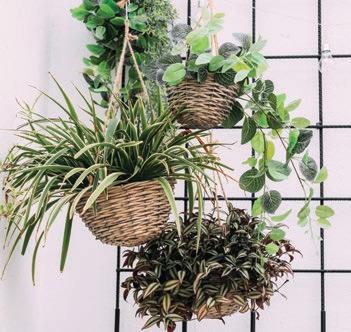






page 10 | About the garden magazine

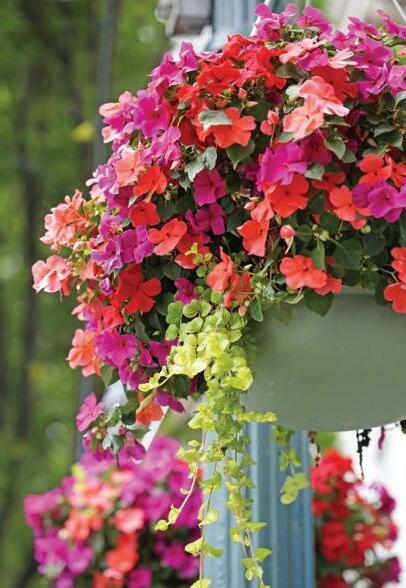



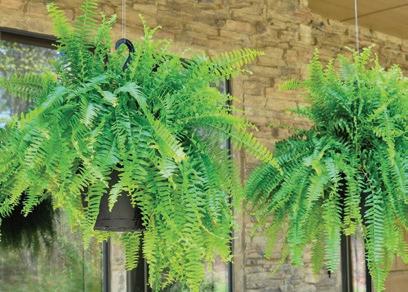
About the garden magazine | page 11
Beetroot









Plant in late spring and early autumn, and winter in frostfree areas.

Good drainage is the main requirement of these otherwise tolerant plants. They are small and fairly slow to develop so they can be grown among faster crops such as lettuce and radishes to maximise the use of available space. Being small, they also make good container-grown vegetables. Beetroots prefer a position in sun, although they can tolerate some shade when cultivated in warmer months.
Broccoli



Plant broccoli when the cooler weather appears. One plant will produce a large crop and ten plants should suffice the needs of an average family. By cultivating a few plants of different varieties which mature at various times, the harvesting period can be extended.

Ensure good drainage and plenty of sunlight to produce a crop. Keep the soil between the broccoli plants weed free and fertilise fortnightly with SeaMax Organic Fertiliser
Plant broad beans late autumn and winter, when high heat and humidity levels have passed. Broad beans need winter chill to trigger fruit set so are unsuitable to grow in tropical areas.
It is essential to grow broad beans in a position where they will receive maximum sunlight. They are large, heavy plants and will need support as they grow, so use a trellis or climbing structure.

Broad beans are susceptible to attack from black aphids which colonise the young growing tips and should be treated with an organic pesticide, Searles Ecofend Vegetable & Garden spray

page 12 | About the garden magazine
Plant cauliflower in autumn and early winter to enable the flowering heads or curds to ripen in cold weather.
Full sun, good drainage and deep, rich soil to accommodate their extensive roots are the basic requirements for cauliflowers – growing them in a raised bed is ideal. They should be protected from frost, so avoid planting them in low-lying and exposed areas where this may be a problem. If heavy frosts have been forecast, protect the head with hay or hessian at night, but remove this during the day to allow air to circulate.
They require liberal quantities of fertiliser to produce the large, edible head so dig in some 5 IN 1 Organic Fertiliser before planting for brilliant results.

Cauliflowers need a steady supply of food and water to develop good heads. Do not let weeds appear between the plants, as these will compete for the nutrients and moisture and inhibit the growth of your cauliflowers. Fertilise fortnightly throughout their growing period with SeaMax Organic Fertiliser.

The main enemy of broccoli is the cabbage white caterpillar which should be removed by hand. If aphids appear on the growing tips of young plants, wash them off with a hose.

Broccoli should be harvested before the compactness of the head is broken by the leafy points bristling through it. If the head has turned yellowish with flowers starting to open, it is too old to pick.
Cabbage



In cooler areas, plant in autumn, winter and spring. In warmer areas and inland plant late autumn and early winter.

















Cabbages dislike wet feet, so good drainage is essential. As with other cold season crops, plant in a sunny position. Compact varieties grow well in pots.
Cabbages have large appetites and so it is important to grow them steadily with an abundant supply of food and water. Enrich the soil with plenty of Searles Soil Improver. Do not let weeds appear between the plants, as these will compete for the nutrients and inhibit the growth of your cabbages.

Cabbages should be picked when their heads feel hard. Dig up the whole plant, sever the head from the stalk with a sharp knife; discard the outer leaves, and store in the fridge until required.

Cabbage white caterpillars are the main problem with cabbages, and should be removed by hand. Heavy infestations can be sprayed with Searles Bug Beater Natural Pyrethrum spray.
Radishes

Plant all year round, except in winter in frosty regions unless cultivating in containers. When cultivating during the warmer months, radishes can be planted in sun, ideally protected from direct exposure by other plants or semi-shade.
They are a quick crop and can be used to fill spaces between other, slower maturing plants. Because they are small, they are ideal to grow in containers.
It is vital to maintain constant moisture levels around the plants for two reasons: to prevent the radishes from splitting; and to make sure they develop at a steady rate otherwise they may acquire an unpleasantly strong flavour. Keep the soil around the plants free of weeds, taking care not to disturb the delicate radish roots. Radishes grown in containers should be fertilised once at seedling stage with a soluble fertiliser such as Searles Flourish Vegetable & Tomato Plant Food.
About the garden magazine | page 13
Plant peas in late autumn and early winter; they like cold weather but the flower buds won’t form until frosts have finished. Select the types most suitable for your climate. Stagger planting every month to prolong the season for produce.





A sunny position is essential for good flower and pod development, although in very warm areas peas can be grown in semi-shade. They are not fussy about their soil providing it is well drained and made fertile with the addition of compost in both heavy and sandy loams.
All peas perform better if they are grown on a trellis or special pea netting, which should be erected before sowing seeds or planting seedlings, to prevent damage to the young plants. Snow peas mature into tall plants so make sure their support is at least 1.8m high.




Searles Liquid Potash can be applied once a fortnight once flowering commences to encourage good pod development.




page 14 | About the garden magazine
Planting
figs










Fig trees love a hot, fairly dry climate so are ideal for most parts of Australia, where they can be planted at any time of year. They need full sun but dislike strong winds, so choose a sheltered position if this is an issue in your area. Although they grow happily in alkaline soils, they especially enjoy a compost-rich, slightly acidic soil, so don’t hesitate to dig plenty of Searles Soil Improver into the soil before planting and fertilise every season with 5 IN 1 Organic Fertiliser. Avoid high nitrogen fertilisers as this will encourage excess leaf production at the expense of fruit. Good drainage is essential, so if you have heavy, clay soil, build up soil in mounds to improve drainage or plant on a slope where water will drain away easily in wet weather. Figs enjoy a Mediterranean climate with hot, dry summers and cool, wet winters, so don’t overwater during the summer. Excessively wet weather or overwatering during fruit set can cause the fruit to split. They can also be sensitive to frost when young, so be prepared to protect them with a towel or shade cloth if necessary, for their first 1–3 winters. Once established, they can tolerate quite heavy frosts. Figs can be grown in large pots. Plant potted figs in Searles Fruit, Citrus & Rose Specialty Mix This mix contains fertiliser to promote fruit production. Potted figs will need to be watered more regularly than figs in the ground.
Harvest
Most fig trees produce two crops annually. The first crop is known as the Breba crop and usually has larger fruit but a smaller yield. The second crop is called the Higos crop and is considered the main crop for the year. Figs are very perishable and fresh fruit are best eaten within days of picking for best quality. Figs are ready to harvest when they droop rather than stand erect on their stems and should feel soft when given a gentle squeeze. The fruit may split slightly and the ‘eye’ at the base of the fruit may form a small opening and ooze a sweet syrup. Hold the fig from the stem and twist-pull gently to remove it. Ripe fruit can be stored in the fridge for several days, but don’t wash it until it is ready to be eaten. Figs can be harvested when almost ripe and allowed to ripen at room temperature indoors. Unripe fruit that is picked prematurely will ooze a milky, latex sap from the stem and will never ripen properly.


Feijoa trees produce an abundance of bi-colour scarlet flowers in spring and by autumn the delicious, fragrant fruit which taste like the tropics will to ready to pick. When not in fruit, their lush evergreen foliage with matte green and silver leaves make for beautiful feature tree in ornamental gardens or in large container plantings.

Feijoa trees prefer cool winters and moderate summers, so are well suited to cooler climates of Australia. They will also grow happily further north in certain regions. Check with your local gardening outlet for the best varieties. They are generally hardy with minimal pests. Find a sunny position in the garden for them with well drained soil. Dig into the soil plenty of Searles Soil Impover to start healthy growth. Fertilise early spring with 5 IN 1 Organic Fertiliser - Fruit & Flower just before flowering and again early summer to develop the fruit.

Prepare


recipes made from garden kitchen produce
simple
500g cooked or pickled beetroot, diced 1 medium size cucumber, cubed 2 eshallots, finely chopped 1 tablespoon of dill, chopped roughly 1/2 cup nuts of your choice, suggestions macadamia or walnut Olive oil Salt & pepper
Refreshing and clean salad for a side dish to steak or as a dip.
bowl all ingredients, drizzle olive oil over the top and season with salt and pepper to taste.
page 16 | About the garden magazine
Toss together in a mixing
Serve cold.
A warm throw-together salad for lazy lunches.


Prepare
Season pumpkin or sweet potato with salt, pepper and olive oil and roast in the oven until softened.
Cook quinoa as per packet instructions.
On a serving plate, lay a light bed of rocket, followed by cooked quinoa, roasted vegetable, figs, cucumber, bocconcini, pomegranate, toss lightly to mix.

Serve

Drizzle more olive oil over the top. www.aboutthegarden.com.au
Bake in a 180˚C oven until crispy, approximately 8 minutes.


wedges
Rocket
Butternut pumpkin or sweet potato, cut in
1 medium sized cucumber, sliced Bocconcini balls, shredded 1 cup Quinoa
Pomegranate Figs, cut in wedges
Kale leaves Canola oil salt
Rip
Ingredients
Prepare
kale leaves to desired size. Lay them flat on baking tray lined with baking paper. Spray with canola, sprinkle with rock salt, if desired.
more recipes,
About the garden magazine | page 17
for
visit
Deadheading is the removal of spent flowers, or ones past their peak, on annuals and perennials.

This may seem pointless, but deadheading regularly promotes more flowers to develop because the plant does not spend energy producing seeds and instead concentrates on continual flowering.
To deadhead, you can snap the faded flower off or cut the flowers off, and utilise this time to shape the plant for a fuller and healthier appearance. The plant’s performance intensifies, and a simple task enhances its appearance. Hidden from view, the root system will also benefit from the energy being diverted away from seed production and back to the overall health and vigour of the plant.
The main principle of an annual is to form seeds and perpetuate the plant’s life cycle; the formation of developed seeds tells the plant it has done its job, and the plant dies off as it has fulfilled its purpose, such as when lettuce flowers. Deadheading delays this cycle, and the plant still strives to develop flowers in the hope of producing viable seeds.
A side benefit is that seed is removed, so unwanted seedlings decrease, and no longer pop up in lawns and gardens. Look at pansies or viola, and the fallen petals expose a swelling seed pod; the plant produces fewer flowers, and then the pod explodes and scatters seed around the immediate area. Remove the spent flowers, and you are rewarded with many flowers to continue through the season. Try a regular deadheading approach this autumn and enjoy healthier plants and extended flowering.
What is NPK?
NPK on the labels of fertilisers refers to the macro nutrients or the nutrients in larger amounts that it contains. All fertilisers must state the NPK analysis on the product as a minimum requirement, the trick is understanding what this means. All of them are essential for plants to survive. The main feature of nitrogen (N) is for growth and greening, phosphorus (P) is for root development, and potassium (K) is for flowering and fruit. A plant in good health can withstand pest and disease attacks better and so the NPK is the basis of the building blocks of overall plant health.
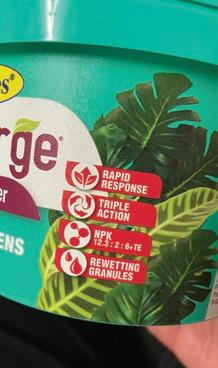
If a plant is low in nitrogen, it goes yellow and has little to no growth. A plant low in potassium struggles to flower and then fruit to its full potential.
Use high in potash fertilisers during flowering and fruiting season. Low in phosphorous fertilisers for natives. High in nitrogen fertilisers for green growth.
NOTE: Organic fertilisers naturally have lower NPKs when compared to inorganic fertiliser, yet organic fertilisers often produce potent, excellent results.
page 18 | About the garden magazine
Fungus gnats (Sciaroidea family) in their adult form can be most annoying invading our interior space in large numbers. But it is their larvae which do the most damage to plants’ roots. Adult flies lay hundreds of eggs at a time in the plants’ soil and their eggs hatch into white worms-like larvae featuring black heads, wreaking havoc by feeding on the roots and soft stem material of the plant, seriously weakening its ability to survive. The fungus gnat’s life cycle from egg to adult flies is just three weeks.
To detect larvae presence, gently dig around the soil for evidence of the worm-like creature. They can also leave a silvery shiny trail on the top layer of the potting mix, similar to snails and slugs.
Tips to controlling Fungus Gnats
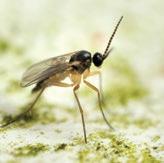

• Fungus Gnats love moist wet soil where they can thrive in great numbers. So be careful not to over water pot plants and let the soil dry out between
watering. This will greatly reduce the numbers of eggs hatching and larvae feasting.
• Avoid leaving leached water in saucer pots. Drain excess water out after watering plants.

• Stop their life cycle by hanging sheets of sticky traps close to the indoor plants to kill the adults before they have a chance to lay their eggs in the soil.
• A physical barrier can also be created to stop the adults accessing the soil to lay their eggs. Mulch thickly over the top layer of soil with stones, gravel and small pebbles.
About the garden magazine | page 19
Ever wondered what those tiny black flying insects are buzzing about in small groups around your indoor plants?
pebbles & gravel are a barrier against gnats
allzones








autumn planting and care guide
> Plant olive trees in autumn in a sunny position in large pots or placed as a feature in the garden. Olives flourish in cool winters with hot dry summers with low humidity. They are tolerant of winds, coastal salt spray, medium frosts and dry conditions. They need some cooling time to be more productive.

> Planting citrus trees in autumn allows roots time to establish a little before winter dormancy. Plant in Searles Fruit, Citrus & Rose Specialty Mix for the right nutrient balance to promote flowering and fruit. Fertilise existing citrus trees with Searles Fruit & Citrus Plant Food while fruit is forming to ensure bountiful crops later on. Keep trees well mulched, water them deeply and regularly. Yellowing older leaves can mean magnesium deficiency, in which case a dose of trace elements will correct any nutrient deficiency.




> Autumn is a great time to plant cool season vegetables, such as brassicas, cauliflower, celery, onion and cabbage. These veggies prefer an alkaline soil, so prepare garden beds by digging in garden lime - along with plenty of 5 IN 1 Organic Fertiliser for good nutritionat least two weeks before planting. If you’re limited for space, miniature varieties of these veggies can be grown in pots with Searles Herb & Vegetable Specialty Mix

> Strawberries grow well during the autumn season. Their pendulous ruby-red fruit make ideal hanging basket displays for easy access. Everywhere outside the tropics, new strawberry plants are best planted by late autumn. Tropical gardeners might prefer to put them in earlier, from March to May to give them the longest growing season. Give strawberries a sunny position and for hanging basket and pots, plant in Searles Fruit, Citrus & Rose Specialty Mix.

> Time to plant a few rows of beetroot. Grow them in sweet, well drained soil and full sun. Sow in early March for a mid May crop.
Keep an eye out for snails and slugs on your veggies, particularly when seedlings are germinating. Silvery trails on the ground and chewed leaves suggest snail or slug activity. These can be kept at bay with regular inspections, hand removal (squashing) or the use of snail baits which have a child and pet deterent. Control them by sprinkling Searles Snail & Slug Killer Pellets near affected areas.

Watch out for whitefly on all brassica crops (including broccoli, Brussels sprouts, cabbages, cauliflower and kale) on the leaves and heads. Netting over the crop is the best protection against this pest, but you should also remove any caterpillars noticed by hand or use a registered organic pesticide such as Searles Ecofend Vegetable & Garden spray.

page 20 | About the garden magazine
all you need for





Your summer crop of tomatoes may be finished, but it’s not too late to plant more if you live in warmer climates! Give tomatoes a welldrained, compost rich soil, full sun and feed fortnightly with SeaMax Organic Fertiliser Liquid.



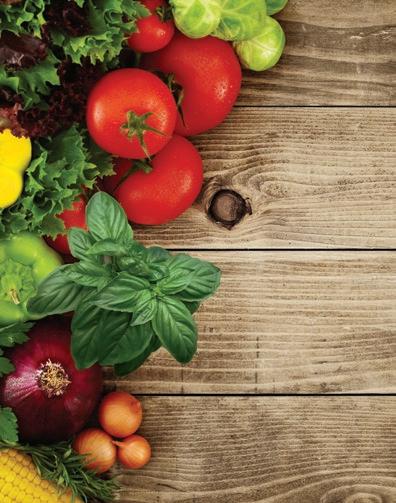
and feed
> Figs produce two crops annually, in autumn and spring, so now is ideal to plant one and enjoy its fruits. Fig trees love a hot, fairly dry climate similar to their native Mediterranean climate with hot, dry summers and cool, wet winters, yet they are ideal for most parts of Australia where frosts aren’t excessive. They need full sun but dislike strong winds, so choose a sheltered position if this is an issue in your area. Their attractive growing habit and ability to grow well in a smallish space make them popular pot specimens. For potted features, plant figs in Searles
Premium Potting Mix and fertilise monthly with Searles Fruit & Citrus Plant Food.



> Now that the last of the summer heat has passed, plant some quick sprouting greens for a culinary supply until the slower growing winter crops have time to produce a harvest. Micro greens, lettuce, dwarf beans, Asian greens (pak choy and Chinese cabbage), sprouts, spring onions, peas, rocket and leafy herbs will produce a crop within weeks. Tip: plant seedlings for quicker produce. Ideal for small areas and in pots for easy reach. Plant in Searles Herb & Vegetable Specialty Mix for excellent deep green leaf growth.
> Plant cool-season herbs like coriander, chives, garlic, marjoram, oregano, parsley, thyme, winter tarragon and rosemary now in pots of Searles Herb & Vegetable Specialty Mix. In big pots, combination of herbs can be planted together for ease of use. In the tropics, now is the time to plant basil, a warm season favourite in zones further south.
FEEDS FOR 9 MONTHS | PROMOTES LUSH GROWTH
Protect herbs, vegetables, trees and shrubs from possums, kangaroos, wallabies, rabbits, hares, bandicoots, deer, foxes and other wildlife.


Protect vegetables, fruit trees, ornamentals, seedlings and buildings from cockatoos, crows, ducks, pigeons, rosellas, starlings, swallows, other birds, fruit bats and microbats.


Protects homes, gardens, patios, shop fronts and paved areas from both dogs and cats or rats and mice.



Protects one plant or a whole area — perimeter &/or band sprays.
Repels — without harming animals or humans. Not considered a poison — no withholding period. Easy to use — spray on. Effective when dry.
Safe, Proven and Effective.
Available in 100g, 1Kg & 4Kg Sizes.
is unique. Reject products said to be "just as good", nothing is at all "like it".
For more specific information send 2 x $1 stamps, Please mention your problem, post to: D-TER, Dept. A, PO Box 3, Oyster Bay, NSW 2225. Enquiries: Phone: (02) 9589 0703 Fax: (02) 9589 0147

GG20-260/02
Guzmanias are a popular bromeliad due to their inflorescent fountain forming bracts, often mistaken for the flower, sitting proud from its centre. Bracts and flowers will last for many months. Its foliage is mostly dark green creating the perfect contrasting backdrop to their luminous bracts. Naturally adapted to lower levels of light than other bromeliads, Guzmania are suitable for indoor decor displays and shadier parts of the garden. Do not expose them to direct sunlight. Guzmanias prefer warmer temperatures and humid spots.
Guzmanias are naturally epiphytic, so they can be grown on a host tree or planted in a specifically designed bromeliad soil mix such as Searles Cymbidium & Bromeliad Mix. If anchoring on a tree, secure the roots firmly around the host as the bracts can be top heavy. Water guzmanias through their centre ‘tank’, the area where the leaves form a cup at the base of the plant to preserve the life of the bract.

Like most other bromeliads, guzmanias will die after flowering, but new pups form before it dies, awarding you new plant and bracts for the next season. The pups can also be gently removed and transplanted elsewhere.

autumn planting and care guide
> You will find some beautiful autumn flowering orchids in stores now. Phalaenopsis are the easiest to care for. All orchids enjoy a liquid feed every couple of months, especially during flowering season with Searles Flourish Orchid Booster.


> Planting natives in autumn gives them time to establish their roots and settle in before the winter months and ready for spring growth. Plant in Searles Native Plant Specialty Mix for the right nutrient ratio for these low phosphorous plants. Natives are susceptible to scale during autumn. Look out for evidence of these insects on leaf stems and branches on bottlebrushes (Callistemon and Melaleuca), lilly pillys (Syzygium), emu bushes (Eremophila) and wax flowers (Philotheca).
> Autumn is ideal to establish a new lawn and give your existing one some more TLC. Newly laid lawns need regular and deep watering plus a little slow release fertiliser to give it extra energy to bed down its roots firmly and thicken.

> Mandevilla’s lush, tropical-style foliage and bold flowers borne from spring until autumn in cooler zones and year-round in the tropics and subtropics make it an all-time favourite in Aussie home gardens. Easy to train over a trellis, this non-aggressive climber grows equally well in pots or garden beds. Give it full sun and protection from frosts.
> Sasanqua camellias come into full bloom in autumn. Like other camellias, sasanquas are long-lived with excellent drought and cold tolerance once established. Plant in Searles Azalea, Camellia & Gardenia Specialty Mix for healthy pots and garden bed displays. Water camellias regularly in the first year of their life to ensure they establish quickly.
> Plant autumn loving beauties like mandevillas, petunias, buddlejas, grevilleas, tibouchinas, orchids, sweet peas, pansies, violas, snapdragons, lobelias, cyclamen, marigold and nasturtium, geraniums, red hot pokers, salvias, camellias sasanquas, dahlias and plumbago. For gardens, plant straight into Searles Planting Mix or use Searles Platinum Potting Mix for potted displays.



page 22 | About the garden magazine
Preparing the garden for bulbs for next seasons
flowering.









Just as true for planting bulbs as in real estate, the most important thing is position, position, position. Not all bulbs are suitable for all regions, so the first objective is to select varieties suitable for your area and planting time. Bulbs take a longer time to establish and flower than seedlings, so they are often planted out a season before their flowering time. Choose where you are going to plant, full sun is the preferred position for most bulbs but always refer to the packet for full direction for your region. As you get into the hotter regions then a light shade is tolerated.
Bulbs do not tolerate wet or boggy ground; well-drained soil is a must, or the bulbs can rot easily. A raised garden bed is an alternative or mound the garden bed to allow for maximum drainage if your soil is heavy. Remove all weeds and turn over the soil to a depth of a shovel. Dig into existing soil Searles Premium Compost Mix and turn it over until it is light and friable. Prepare the beds a few weeks before planting, pulling out any weeds that sprout before planting.
When you plant the bulbs, place a label or stake at each site to identify their position so they are not mistaken for weeds when they shoot. A light covering of sugar cane mulch will suppress weeds and keep soil temperature even. Do not be tempted to fertilise heavily until the plant has sprouted fully, keep to a gentle fertiliser such as Seamax Organic Fertiliser which will decrease plant stress and increase the plant’s establishment rate.
If the soil condition in your garden does not favour bulbs, then plant them in pots. Do not plant them too close to the sides of the pot as the heat will radiate onto the bulb and may cause damage. Use a premium potting mix with good drainage and follow the guides on how deep to plant. If the bulbs are planted too deep, they cannot reach the surface of the soil and will perish. Planted not deep enough the plant becomes top heavy and may topple over. Label the pot as to the bulb type and check if the bulbs need to be raised and stored in the off season.
Once the bulbs have started to shoot green leaves, then you can start to water. If you water when the bulb is still dormant it can cause rot. The soil is to be kept moist not wet and stop watering once the flower has finished and the leaves start to change colour and shrivel. One of the easiest bulbs to grow and plant in autumn is freesia, they grow in most parts of Australia and are usually a low care plant. Bluebells and grape hyacinths also perform well and a great beginner bulbs, better still, they will keep reappearing each year.
(Pelargonium peltatum)



Although lacking the level of flamboyance as Regals and Zonal pelargoniums and not lacking perfume, the Ivy leaved pelargoniums have maintained their popularity over decades.
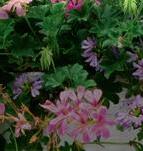
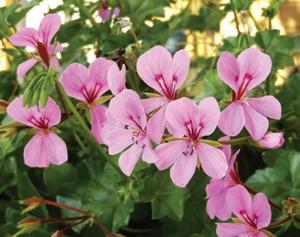
Most common guzmania is the Guzmania lingulata
Their trailing habit and ivy shaped foliage make them easy and great choices for use in hanging baskets or on retaining walls where their gentle trailing habit is greatly admired. This group carries the widest array of flower colour in all shades along with the occasional variegated leaf forms and can be used in countless combinations for mixed window boxes or mixed planters.
They hold their blooms well clear of the shiny foliage and can be rapid growers in the right location. Although they will handle a full sun location during autumn, winter and spring, they prefer a little protection from the intensity of the summer sun.
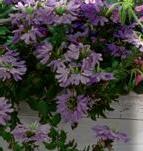

Some varieties are well suited as small climbers on low fence lines where they will clothe their structure and smother themselves in multitudes of blooms.
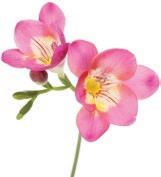

About the garden magazine | page 23
by climatic zone



> No plant signals the end of a searing hot summer with a more brilliant hue of purple than the tibouchina! The traditional tree-like tibouchina ‘Alstonville’ is still a favourite seen in many gardens. New dwarf varieties are growing in popularity every year, filling small gardens and courtyards with lush, shimmering shades of purple, mauve and even white.
> Golden Penda ‘Fairfill Gold’ (Xanthostemon chrysanthus) is a spectacular flowering shrub, originating from north Queensland. Plant in welldrained soil in full sun or part shade, mulch well and keep it well watered while establishing. Attracts nectar-feeding birds.
Geraniums, salvias, dahlias and mandevillas are showing their brilliance in the autumn garden. Plant Searles Planting Mix for brilliant garden results or for potted displays, use Searles Platinum Potting Mix for 18 month feeding.
Tomato seedlings can be planted again early autumn. As the weather cools, start preparing your veggie patch for winter vegetables, such as, broad beans, broccoli, cauliflower, lettuce, onion, peas, radish, shallots, spinach, spring onion, sweet corn and turnip. Dig Searles Soil Improver into the soil prior to planting seedlings.
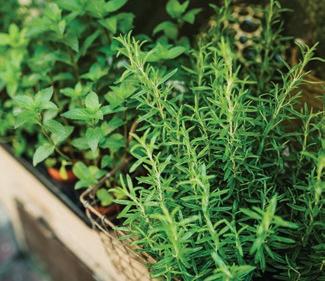
Iron chlorosis is a common condition in garden plants which appears as a yellowing between the veins of leaves. It indicates that the plant is deficient in iron, which is caused by the soil being either too alkaline, or simply iron deficient. Iron chlorosis can be corrected with Searles Iron Chelate.


Hervey Bay Brisbane Toowoomba Warwick Grafton Port Macquarie For more information for what to grow in your climatic zone visit www.aboutthegarden.com.au page 24 | About the garden magazine
Use Searles
Rockhampton
Most herbs can be planted in autumn.
Herb & Vegetable Mix for potted herbs.
> Acalypha Inferno will add a pop of colour to a dull corner of your garden. Its fiery red foliage works well with contrasting plants, cordylines are the perfect partner. A sunny position will intensify the colour of their foliage. Look out for the smaller version, Acalypha Firestorm.
> Shining almost as brighter than the sun, Allamanda Sunee is a low-growing shrub form of the popular glossy-leaved tropical climber, Golden Trumpet vine, featuring bright yellow flowers. Beautiful container plant when used to create a screen on patio settings.
> It is hard not to be stung by Alocasia Stingrays’ unqiue tropical rainforest foliage. The large variety have very large green upright leaves, with prominent speckled stems, taper to a long point like the tail of a stingray. Look out for the smaller version too.
Alocasia Stingray

> For autumn pot colour and to fill the garden with bright colour, plant calendula, dianthus, pansy, zinnia, gerbera, snapdragon, petunia, sunflower, nasturtium and marigolds. Plant in Searles Garden Soil for gardens or Searles Platinum Potting Mix for great potted results.

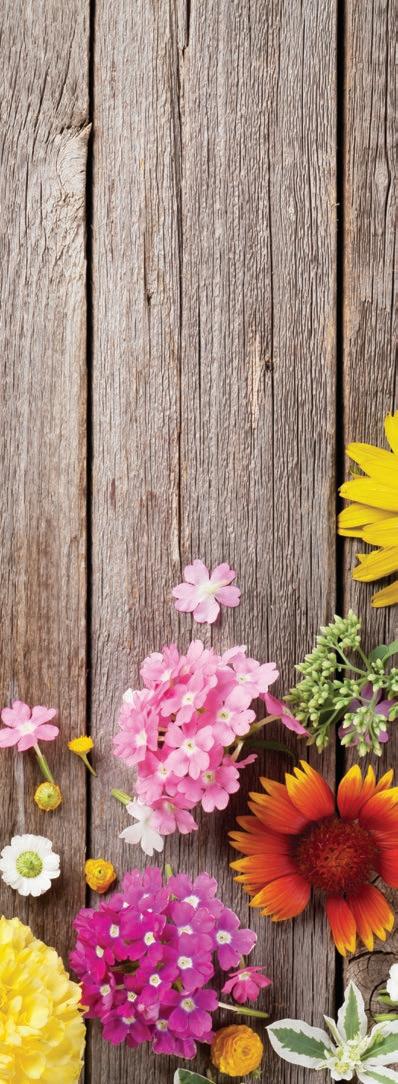
> Winter cropping vegetables, such as, broccoli, cauliflower and cabbage can be sown now. Artichoke (globe), beans, beetroot, capsicum, carrots, celery, chives, dill, eggplant, kale, leeks, lettuce, onion, parsnip, potato, pumpkin, radish, rocket, rockmelon, squash, sunflowers, sweet corn, tomatoes, watermelon and zucchini can go into the veggie patch.


> Plant new citrus, Davidson’s plum, loquat, macadamia and avocado now. Before planting, mix into existing soil 5 IN 1 Organic Fertiliser to provide plenty of organic nutrients for growth.



or follow us on


www.aboutthegarden.com.au/purchase
OR Pay by direct debt. We will send you account details via email. Cheques will not be accepted. www.aboutthegarden.com.au


............................................................................... Age:
Address: ........................................................................... .................................... City: ............................................ State: .............. P/code: ................... Phone: .............................................................................. Email: ............................................................................... 1 year ($19.00) 2 years ($31.00) Payment Methods Charge this to my: Visa Mastercard Card no: Card holder’s name:.......................................................... Expiry date: ................Signature: ..................................... Autumn 2023 Please send this form to: About the Garden P.O.
atg@aboutthegarden.com.au Ph:(07) 5422 3090 FOLLOW US ON Darwin Cairns Rockhampton Brisbane Emerald Longreach Mt. Isa
Name:
25–35 36–45 46–55 55+
Box 183 Kilcoy Q. 4515
or subscribe online
or scan QR code
> Plant alyssum, calendula, candytuft, carnation, cineraria, cornflower, cosmos, daisy, foxglove, lobelia, nasturtium, nemesia, pansy, poppy, primula, schizanthus, snapdragon, sweet pea and viola.


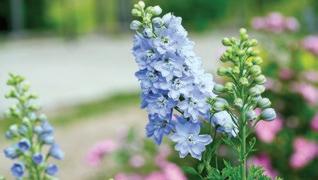


> The mild weather brings good conditions to plant new fruit trees, such as, citrus, passionfruit vines, feijoas, figs and pomegranate. Prepare soil by mixing into the soil Searles 5 IN 1 Organic Fertiliser to turbo charge the soil with nutrients for good rooting and future growth.
> Camellias sasanquas are flowering now. Ask your local gardening centre expert for the most successful varieties to grow in your garden style. Plant new camellias in Searles Azalea & Camellia Plant Food to establish good root growth and healthy foliage and flowers.
> Give gardens and pot plants a recharge after the summer heat with Searles Recharge Pots & Gardens Ultimate Fertiliser. This dual acting fertiliser and re-wetting granules will provide a well earned fertiliser boost while ensuring the water absorbs into the soil reaching the roots.
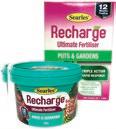
> Treat aphids, thrips, mites and powdery mildew on roses and ornamentals with triple action Searles Trifend Complete Garden Spray
> Plant avocado, persimmon, loquat, olive and feijoa trees. Plant all citrus including mandarins, lemons, limes, oranges and kumquats. Harvest the rest of your summer produce such as pumpkin and capsicum.
> Deciduous trees such as maples and golden ash develop vibrant autumn colours. The smoke bush (Cotinus coggygria) is a tall deciduous shrub that relishes cold winter conditions. In autumn, its dark purple leaves turn to red and orange colours.
> Fertilise roses with Searles Rose & Flower Plant Food every 3 weeks for their next flowering flush. Check regularly for any early signs of pests or fungal diseases. Treat with Searles Rose Pro Spray Prune roses to encourage new growth.

> Winter veggies can be planted now. Plant beans, beetroot, cabbage, capsicum, carrot, cauliflower, cucumber, English spinach, kohlrabi, leek, lettuce, onion, parsnip, pumpkin, radish, silver beet, spring squash, swede, sweet corn, tomato, turnip and zucchini. Prepare vegie patch two weeks prior with 5 IN 1® Organic Fertiliser to give your produce the best results. For veggies in pots, use Searles Herb & Vegetable Specialty Mix. Keep up the water and remove weeds from around the base of the plant to keep the plant performing optimally.


brings.


Tibouchinas are flowering in autumn
For more information for what to grow in your climatic zone visit
Hobart Rockhampton Hervey Bay Brisbane Warwick Grafton Port Macquarie Sydney Canberra Melbourne Wodonga Adelaide Geraldton Perth Albany Port Augusta Esperance Moree Armidale Orange
Emerald Rockhampton Gladstone Hervey Bay Brisbane Toowoomba Warwick Port Macquarie Sydney Melbourne Wodonga Adelaide Albany Esperance Armidale Tamworth TM page 26 | About the garden magazine
Larkspur love the cold weather autumn
> Olive trees, fig trees, citrus trees, loquat, grapes, bay trees, quince and pomegranates are all extremely popular choices to plant in Mediterranean gardens in autumn. Many of these also perform well in pots which makes the style ideal for compact courtyard gardens too. In pots and gardens, plant in Searles Fruit, Citrus & Rose Specialty Mix

> Lavender, rosemary, roses and oleanders are all Mediterrannean classics which makes them hardy garden choices.
> Plant winter annuals such as panises, violas, poppies, snapdrgaons, primulas and cinerarias. For garden and potted colour, plant dianthus, gypsophila, hollyhock, impatiens, lobelia, marigold, pansy, snapdragon and violas.
> Plant tomatoes, capsicum and zucchini early autumn for another crop before winter sets in. Winter veggies can be planted later in the season. artichoke, broccoli, cabbage, cauliflower, cress, leek, lettuce, radish, onion, shallot and silverbeet can go in.
> Chives, marjoram, mint, oregano, parsley, sage, tarragon and thyme are great autumn growing herbs.
> Fertilise roses with Searles Rose & Flower Food to keep their plant health which in turn helps to fight off pests and diseases.
Silver foliage reflects the sun’s heat and helps plants to conserve water.




Try Senecio cineraria.
> Ensure the water is reaching the plant’s root and is not hydrophobic by applying Searles Penetraide Re-Wetting Granules onto the soil and water in.

> Look out for autumn garden plant pests such as scale, citrus leaf miner and mealybug, treat with Searles Ecofend Fruit & Garden spray at first sight. Hang fruit fly traps around your citrus and vegetable garden to monitor the presence of fruit fly.
> Plant olive, fig, citrus, passionfruit, pomegranate, strawberries and loquat trees. Mix into existing soil some 5 IN 1 Organic Fertiliser to feed their hungry nutrient requirements, water well and mulch after planting. For pot planting, use Searles Fruit, Citrus & Rose Specialty Mix
> Plant beetroot, broccoli, carrot, brussel sprouts, cabbage, cauliflower, Chinese cabbage, endive, lettuce, leeks, onion, silver beet, shallots, snow pea and spring onion. Plant garlic cloves and onion seedlings. Grow leafy greens fast and pick young for the tasty result. Water daily and liquid feed fortnightly for quick growth.
> Acacias, sennas, eucalypts, eremophilas, grevilleas, melaleucas, callistemon and native grasses are all water wise plants for the bush garden. Australian natives such as aloes, gazanias, salvias and pigfaces spread throughout the garden make for hardy colour.
> If pot plants are your inland garden, plant chrysanthemum, cockscomb, cosmos, dahlia, everlasting daisy, gazania, geranium, gerbera, impatiens, kangaroo paw, marigold, nasturtium, petunia, portulaca, rudbeckia, salvia, snapdragon, sunflower, torenia, verbena, wallflower and zinnia for autumn colour. For long lasting nutrients to feed flowering, plant in Searles Platinum Potting Mix. This mix feeds for 18 months.


www.aboutthegarden.com.au or follow us on

Perth Hobart Emerald Rockhampton Gladstone Hervey Bay Brisbane Toowoomba Grafton Port Macquarie Newcastle Sydney Wodonga Adelaide Albany Port Augusta Tamworth Orange Brisbane Kalgoorlie Carnarvon Alice Springs Perth Hobart Emerald Rockhampton Gladstone Hervey Bay Toowoomba Grafton Port Macquarie Newcastle Sydney Wodonga Adelaide Albany Port Augusta Tamworth Orange
About the garden magazine | page 27


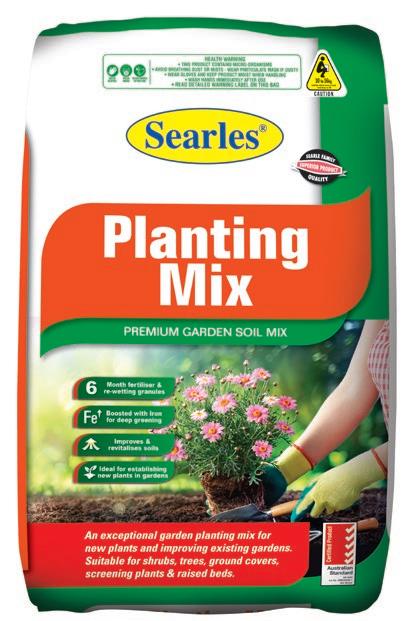
Ask for Searles quality garden products at your nearest gardening outlet. www.searlesgardening.com.au • Feeds plants for 6 months.
































 CLIMBER
CLIMBER

















































































































































































































